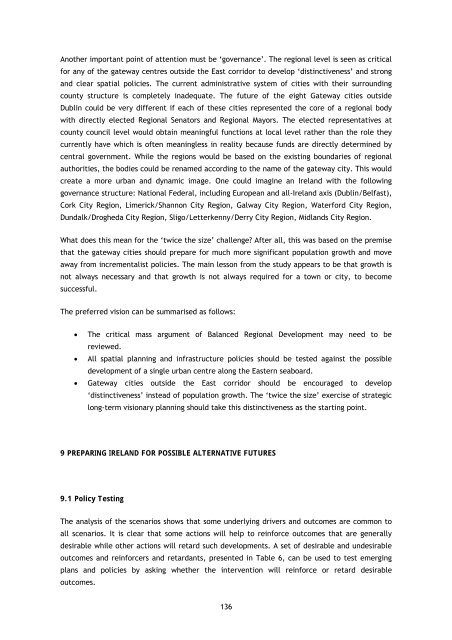TWICE THE SIZE - DIT Update - Dublin Institute of Technology
TWICE THE SIZE - DIT Update - Dublin Institute of Technology
TWICE THE SIZE - DIT Update - Dublin Institute of Technology
You also want an ePaper? Increase the reach of your titles
YUMPU automatically turns print PDFs into web optimized ePapers that Google loves.
Another important point <strong>of</strong> attention must be ‘governance’. The regional level is seen as critical<br />
for any <strong>of</strong> the gateway centres outside the East corridor to develop ‘distinctiveness’ and strong<br />
and clear spatial policies. The current administrative system <strong>of</strong> cities with their surrounding<br />
county structure is completely inadequate. The future <strong>of</strong> the eight Gateway cities outside<br />
<strong>Dublin</strong> could be very different if each <strong>of</strong> these cities represented the core <strong>of</strong> a regional body<br />
with directly elected Regional Senators and Regional Mayors. The elected representatives at<br />
county council level would obtain meaningful functions at local level rather than the role they<br />
currently have which is <strong>of</strong>ten meaningless in reality because funds are directly determined by<br />
central government. While the regions would be based on the existing boundaries <strong>of</strong> regional<br />
authorities, the bodies could be renamed according to the name <strong>of</strong> the gateway city. This would<br />
create a more urban and dynamic image. One could imagine an Ireland with the following<br />
governance structure: National Federal, including European and all-Ireland axis (<strong>Dublin</strong>/Belfast),<br />
Cork City Region, Limerick/Shannon City Region, Galway City Region, Waterford City Region,<br />
Dundalk/Drogheda City Region, Sligo/Letterkenny/Derry City Region, Midlands City Region.<br />
What does this mean for the ‘twice the size’ challenge? After all, this was based on the premise<br />
that the gateway cities should prepare for much more significant population growth and move<br />
away from incrementalist policies. The main lesson from the study appears to be that growth is<br />
not always necessary and that growth is not always required for a town or city, to become<br />
successful.<br />
The preferred vision can be summarised as follows:<br />
• The critical mass argument <strong>of</strong> Balanced Regional Development may need to be<br />
reviewed.<br />
• All spatial planning and infrastructure policies should be tested against the possible<br />
development <strong>of</strong> a single urban centre along the Eastern seaboard.<br />
• Gateway cities outside the East corridor should be encouraged to develop<br />
‘distinctiveness’ instead <strong>of</strong> population growth. The ‘twice the size’ exercise <strong>of</strong> strategic<br />
long-term visionary planning should take this distinctiveness as the starting point.<br />
9 PREPARING IRELAND FOR POSSIBLE ALTERNATIVE FUTURES<br />
9.1 Policy Testing<br />
The analysis <strong>of</strong> the scenarios shows that some underlying drivers and outcomes are common to<br />
all scenarios. It is clear that some actions will help to reinforce outcomes that are generally<br />
desirable while other actions will retard such developments. A set <strong>of</strong> desirable and undesirable<br />
outcomes and reinforcers and retardants, presented in Table 6, can be used to test emerging<br />
plans and policies by asking whether the intervention will reinforce or retard desirable<br />
outcomes.<br />
136








